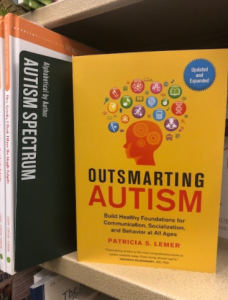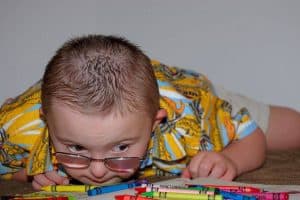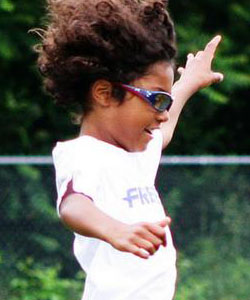Over 6 in 10 children with Down Syndrome experience vision problems. How can parents and teachers help?
Down syndrome is a chromosomal disorder that affects a person’s development both physically and cognitively, with an incidence of over 1 in 800 births.
Up to 60% of children with Down syndrome have severe vision problems that can impact their life and make learning more difficult.
Parents and teachers need to be aware of these problems so they can proactively ensure that any visual difficulties are detected and dealt with. This will minimize the impact of these difficulties on the child, and allow them to thrive in and out of the classroom.
Down syndrome and vision problems
Visual development in the early years of a child’s life will influence the way they are able to function in everyday life, and how they will eventually be able to learn in school. It is influenced both by genetics and the visual input and information a child is able to gather as they observe and interact with the world around them.
Over the last quarter century, a great deal of research has been done into how vision develops in a child with Down syndrome, and how these developments will affect their view of the world.
Some common vision issues Down syndrome can cause include:
Refractive errors
A refractive error occurs when the eye is not properly shaped, or there is a problem with the cornea or lens of the eye. These cause light entering the eye to focus either too far forward or too far back in the eye, making images blurry at certain distances.
Common refractive errors include myopia (nearsightedness), hyperopia (farsightedness) and astigmatism (blurring of vision at all distances).
Research published in Clinical and Experimental Optometry (January, 2015), shows that close to 80% of children with Down syndrome require optical correction.
Though many children have refractive errors as infants and small children, these errors tend to improve in most children, but this improvement does not seem to take place in children with Down syndrome.
Impaired focusing
Many children with Down syndrome have difficulties with the focusing skills on the eyes.
Multiple studies, including one in Investigative Ophthalmology & Visual Science (May, 2004), have shown that most children with Down syndrome struggle with difficulties in focusing.
Focusing refers to the eyes’ ability to change the shape of the lens accurately and efficiently to keep images in focus as a person shifts from near focus to far focus or vice versa.
Difficulties in this area cause blurry vision each time the child has to change focus on what they’re looking at and can also result in headaches, eye strain and frustration.
SEE RELATED:
Vision and Special Needs
For more information about how Down syndrome can affect your child’s vision, and how you can help, contact your eye doctor near you.
Binocular vision problems
It is not enough that each eye should work well on it’s own, it’s also important to make sure that the eyes work together in unison to produce what’s known as binocular vision.
People with Down syndrome are significantly more likely to experience conditions that impact their binocular vision, such as eye turns (strabismus) and lazy eye.
Binocular vision is the eyes’ ability to work together to easily collect visual information to send to the brain for interpretation.
Binocular vision problems can cause headaches, double or blurry vision and eye strain.
Eye health issues
A 2015 study in Clinical and Experimental Optometry, Down syndrome also affects the lens of the eye, causing an increased risk of cataracts earlier in life.
It is especially important to ensure that infants with Down syndrome have their eyes checked, as over 2% of babies with Down syndrome will have cataracts in infancy.
Early detection and treatment is the best way to ensure continued eye health and good vision.
Issues with the way Down syndrome causes the eye to develop create an increased risk of malformation of the cornea, resulting in keratoconus and other problems that can result in inflammation of the eyelids, known as blepharitis.
How to help
In light of the many ways that Down syndrome has been shown to affect a person’s vision, a number of recommendations can be made to help a child adapt and thrive in school and at home.
These recommendations include:
1. Frequent eye exams
Children who live with Down syndrome have a high potential for developing vision-threatening eye disease as well as eye issues that may severely affect learning and every day function.
For this reason, children with Down syndrome should see an eye doctor for an eye exam every six months.
2. Eyeglasses at an earlier age
Several studies, including one published in Developmental Medicine & Child Neurology (July, 2007), have reported that prescribing eyeglasses at an earlier age to children with Down syndrome can help promote proper vision development and prevent eye strain, blurry/double vision and other symptoms which can lead to discomfort and frustration.
In some cases, these eyeglasses may include bifocal or multifocal lenses, to correct for focusing issues as outlined above.
3. Accommodations in the classroom and at home
Parents and teachers are encouraged to create accommodations within the home and classroom that will allow the child to more easily navigate, understand and participate in these environments.
Placing the child towards the front of the classroom, closer to the board can help, as can larger font in writing and visual prompts such as photographs and drawings.
LEARN MORE: Vision for Special Needs
If your child has Down syndrome, schedule an appointment with an eye doctor near you as vision correction could significantly improve their quality of life.
Up to 60% of children with Down syndrome have severe vision problems that can make their life and learning more difficult.
Parents and teachers need to be aware of these problems so they can proactively ensure that any visual difficulties are detected and dealt with.









